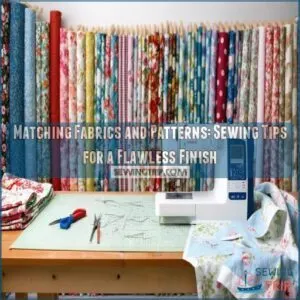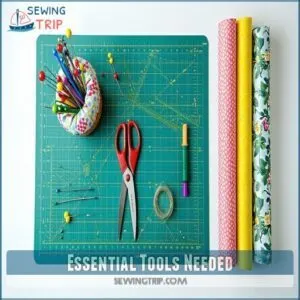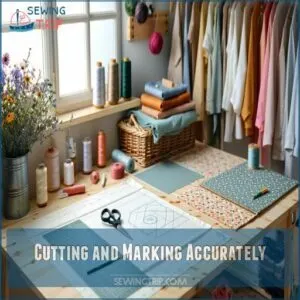This site is supported by our readers. We may earn a commission, at no cost to you, if you purchase through links.

Start by choosing fabrics with similar weights and textures to keep things balanced.
Stripes and plaids? Think of them like lining up stripes on a barcode—precision is key.
For florals, center those motifs like framing a perfect snapshot.
Lay your fabric flat, study the grain, and measure pattern repeats for smooth alignment.
Use sharp fabric scissors, sturdy pins, and a cutting mat to prevent any slipping accidents.
Stick around—mastering these basics is just the beginning of your pattern-matching transformation!
Table Of Contents
- Key Takeaways
- Fabric Pattern Types
- Essential Tools Needed
- Preparing Fabric Correctly
- Basic Matching Techniques
- Advanced Pattern Matching
- Pattern Distortions Prevention
- Fabric Grain and Repeat
- Cutting and Marking Fabric
- Sewing and Matching Patterns
- Mastering Pattern Matching
- Frequently Asked Questions (FAQs)
- Conclusion
Key Takeaways
- Choose fabrics with similar weights and textures for balance, and always wash, press, and prep them before cutting.
- Align stripes, plaids, or bold motifs with precision using pins and careful measurements to ensure seamless pattern flow.
- Use tools like sharp fabric scissors, cutting mats, and marking tools to prevent shifts and ensure clean cuts.
- Pay attention to fabric grain and pattern repeats for professional-looking matches that align perfectly across seams.
Fabric Pattern Types
Choosing the right fabric pattern can feel like picking an ice cream flavor—it’s hard to go wrong, but some options suit your project better than others.
Whether it’s bold stripes, playful florals, or structured geometrics, each pattern type brings its own quirks and charm to your sewing table.
Stripes and Plaids
Stripes and plaids demand patience, but the payoff? Chef’s kiss perfection.
For crisp stripe alignment or balanced plaid designs, slow down and focus on these key steps:
- Match seams for pattern symmetry – don’t let mismatched lines steal the show.
- Watch fabric texture, ensuring smooth alignment.
- Color coordination matters – tone clashes kill the vibe.
Mastery awaits!
Florals and Geometrics
Floral prints bring elegance, while geometric patterns add modern flair.
Matching fabrics with floral arrangements means centering bold blooms, like a garden in perfect harmony.
Geometric shapes, with their crisp lines and angles, demand precision.
Understanding fabric properties is essential for achieving a flawless finish.
Pattern mixing? Possible—if the fabric texture and color combinations sync beautifully.
Nail pattern matching by treating each fabric’s personality like a puzzle piece.
Identifying Pattern Repeats
So, you’ve mastered floral flair and geometric charm—now let’s get into pattern repeats.
Spotting them is like finding rhythm in textile designs. Lay out your fabric flat and smooth, then start your fabric inspection:
- Measure repeat distances for design alignment.
- Study motifs for repeat identification.
- Use a ruler for precise pattern analysis.
Get focused, and those matches will sing!
Essential Tools Needed
You can’t create sewing magic without the right tools in your corner—think fabric scissors sharp enough to rival your wit and pins that actually stay put.
A sturdy cutting mat and reliable marking tools make pattern matching less frustrating and a lot more fun.
High-Quality Fabric Scissors
Selecting the right fabric shears can make or break your project. A razor-sharp blade guarantees precision edge retention, keeping those fabric patterns crisp.
Look for scissor handle ergonomics—your hands will thank you! Regular sharp blade maintenance is a must. Mastering cutting technique tips also prevents frays, ensuring smooth cuts.
Quality shears simplify fabric coordination and flawless textile designs. Understanding the correct scissor sizes is vital for achieving professional-looking results in various sewing projects.
Marking Tools and Pins
Like a sewing superhero’s trusty sidekick, your marking tools and pins can make or break your pattern matching game. These precision warriors help you nail fabric coordination with surgical accuracy.
Here’s your arsenal for success:
- Sharp fabric markers with contrasting colors
- Fine-point chalk pencils
- Extra-sharp glass-head pins
- Seam guides for perfect alignment
- Notching tools for intricate pattern matching
For maximum results, utilize fabric markers to guarantee precise and lasting marks on your fabric.
No detail escapes your creative control!
Cutting Mats and Tables
Before dawn breaks, grab a cutting mat that’s your secret weapon for pattern matching magic.
Different table sizes and mat materials can dramatically boost your cutting accuracy and workspace efficiency.
Pro tip: Choose a self-healing mat with grid lines that’ll make fabric preparation a breeze, keeping your pattern repeats perfectly aligned and your sewing game strong.
Preparing Fabric Correctly
You’ll want your fabric to be primed and ready before you start cutting, which means washing, drying, and pressing it just right.
Taking these essential prep steps guarantees your final project looks professional and prevents unexpected shrinkage or warping that could ruin hours of careful sewing.
Washing and Drying Fabric
After carefully selecting your fabric scissors and marking tools, it’s time to prepare your fabric.
Tame potential shrinkage by washing fabrics in the recommended water temperature.
Pre-shrink your material to prevent warping later, ensuring your carefully matched patterns stay true.
Machine wash or hand wash based on fabric care instructions, then gently dry to maintain the fabric’s original texture and integrity.
Pressing and Ironing Fabric
Once you’ve washed your fabric, it’s time to smooth out those stubborn wrinkles.
Grab your iron and set it to the right heat for your fabric type. Steam Pressing works magic on most prints, helping fabric relax and lay flat.
To achieve a professional finish, understanding pressing techniques is essential for preparing your fabric correctly.
Pro tip: Always test a small corner first to avoid accidentally scorching your beautiful material. Gentle, even strokes are your best friend.
Identifying Pattern Repeats and Motifs
Just pressed your fabric? Now’s the time to become a pattern detective! Spread out your fabric and hunt for design elements that dance across the surface.
Look for recurring motifs – those sneaky little shapes that pop up again and again. Measure the distance between identical points to nail your pattern repeat and set yourself up for sewing success.
Basic Matching Techniques
In the context of sewing, matching fabrics and patterns can transform your project from good to absolutely stunning.
You’ll want to master these basic techniques that’ll have your seams looking so seamless, even professional designers will do a double-take.
Matching Stripes and Plaids
Most sewists break out in a cold sweat when facing stripe and plaid alignment, but mastering pattern matching isn’t rocket science.
Prioritize seam visibility by starting with center front and back. Cut some pieces on the bias for visual interest, and use tracing paper to visualize your alignment before scissors meet fabric.
To improve your skills, consider taking an advanced sewing class that covers various techniques. Your textile symmetry will thank you.
Centering Floral Motifs
After wrestling with stripes, you’ll find floral motifs add a whole new dance to pattern matching.
Centering those blooming beauties takes skill – position prominent flowers on bodice fronts and pockets like you’re curating a garden.
Aim for symmetry, balance your design, and let each petal sing exactly where you want it. Your fabric becomes art.
Matching Geometric Patterns
In the context of geometric patterns, precision is your secret weapon for nailing that perfect look.
Tackle grid matching and shape rotation like a pro by carefully aligning angular elements across your fabric.
Pay close attention to pattern symmetry, ensuring each geometric motif lines up seamlessly.
Your keen eye and steady hand will transform those tricky patterns into a flawless masterpiece.
Advanced Pattern Matching
Ready to take your sewing skills to the next level with advanced pattern matching techniques that’ll make your projects look professionally crafted?
You’ll learn to tackle those tricky curved seams, master one-way designs, and create seamless matches that’ll turn heads and make other sewists green with envy.
Curved Seams and Princess Lines
Ready to conquer those tricky curved seams and princess lines?
Mastering seam navigation takes more than just pinning and hoping. Your secret weapon? Precision and patience.
Use extra pins to tame fabric’s wild side, and cut with gentle curves that follow the pattern’s flow.
Fabric manipulation isn’t magic—it’s skill you’ll build, one Princess Technique at a time.
Sleeves and Collars Matching
Pattern wizards, your sleeve and collar matching secret weapon starts at the shoulder seam.
Trace your fabric’s design carefully, pinning sleeve caps to maintain pattern continuity and fabric flow.
Strategic placement guarantees your seam alignment looks professional, not pieced together.
Align motifs precisely, letting each stitch tell a story of painstaking craftsmanship that elevates your sewing game.
One-way Designs and Border Prints
Ever wrestled with those tricky one-way designs that demand laser-sharp attention? Directional prints and border prints can make or break your sewing project, turning fabric orientation into an art form.
Here’s your survival guide:
- Check fabric direction like a detective
- Cut pieces with strategic print placement
- Embrace the challenge of asymmetrical designs
Mastering these techniques transforms potential headaches into sewing victories.
Pattern Distortions Prevention
Ever wondered why your beautifully cut fabric looks wonky after sewing?
Pattern distortions can turn your sewing project from chic to chaos, but with a few smart tricks, you’ll keep your patterns perfectly aligned and your finished piece looking professional.
Misalignment Along Seams
Slipping seams can turn your sewing project into a bumpy ride!
When pattern slippage threatens your fabric’s perfect alignment, strategic pinning becomes your secret weapon.
Anchor those tricky edges with extra pins, focusing on seam allowance points.
Carefully match each section, checking twice before stitching.
Small adjustments prevent big headaches, keeping your fabric’s flow smooth and professional.
Fabric Shifting During Sewing
When stripes start wandering and plaids begin to dance, fabric shifting can turn your sewing project into a frustrating puzzle.
Master the art of keeping fabric in line with these pro tips:
- Adjust sewing speed control for smoother fabric movement
- Use specialized fabric grip techniques
- Maintain consistent thread tension
- Calibrate your sewing machine precisely
Stay in control, and watch your patterns snap perfectly into place.
Importance of Finishing Touches
Those final finishing touches can make or break your sewing project.
Thread colors and seam finishing techniques are your secret weapons for creating a polished look.
Edge binding and careful hemming transform good work into professional-grade craftsmanship.
Fabric stabilizers help maintain your precise pattern matching, ensuring every seam looks crisp and intentional.
Master these details, and you’ll shine.
Fabric Grain and Repeat
Ever wondered why some sewing projects look picture-perfect while others seem slightly off?
Understanding fabric grain and pattern repeats is your secret weapon to transforming good projects into show-stopping, professional-looking masterpieces.
Understanding Fabric Grain
After wrestling with pattern distortions, you’ll want to master fabric grain – your secret weapon in sewing perfection.
Understanding how threads align creates the roadmap for flawless projects. Grain direction isn’t just technical talk; it’s the invisible skeleton of your fabric, guiding how it drapes, stretches, and behaves under your needle.
Know your grain, rule your craft.
Recognizing Pattern Repeats
When you’re diving into pattern matching, spotting those repeats is your secret weapon.
Look closely at your fabric—each design has its own rhythm.
Measure the distance between identical points, tracing the pattern’s unique dance across the material.
This pattern analysis isn’t just technical; it’s your roadmap to sewing magic that makes pros jealous.
Aligning Grainline and Pattern
Nailing your fabric’s grain alignment is like finding the perfect dance partner for your textile project.
Your pattern’s grainline acts as a compass, guiding you toward seam accuracy and pattern flow.
By matching grain lines precisely, you’ll prevent twisting, guarantee smooth draping, and create garments that move as beautifully as you do.
Understanding pattern grainlines is essential for achieving professional results in dressmaking.
Cutting and Marking Fabric
In the context of sewing, cutting and marking your fabric can make or break your entire project, so you’ll want to treat this step like a precision art form.
Grab your sharpest scissors, a smooth flat surface, and your keen eye for detail – you’re about to transform that beautiful fabric into a masterpiece that’ll have everyone asking, "Did you really make that?
Smoothing Fabric on Flat Surface
A crisp, flat surface is your secret weapon in fabric preparation.
Smooth sailing starts with the right approach to fabric relaxation and wrinkle removal.
Here’s how to transform your workspace into a pattern-matching paradise:
- Choose a large, clean cutting mat or table
- Spread fabric with gentle, even tension
- Use a lint roller to remove stray threads
- Press fabric with a hot iron before cutting to achieve a clean cutting mat or table setup
Laying Out Fabric Carefully
Fabric spread like a canvas demands your full attention. Carefully laying out your material is an art form that can make or break your sewing project.
Understanding fabric handling techniques is essential for a flawless finish. Check out these pro tips for perfect fabric placement:
| Technique | Key Tip |
|---|---|
| Surface Prep | Use clean, flat area |
| Fabric Direction | Match grainline carefully |
| Smoothing Method | Gentle hands, no stretching |
Precision is your secret weapon in pattern matching magic.
Cutting and Marking Accurately
Now that your fabric’s smooth and ready, grab those sharp scissors and mark with precision.
Your cutting techniques can make or break pattern matching. Use fabric chalk or washable markers to outline seam allowances accurately.
Work slowly, keeping your lines straight and true. Each careful cut brings you closer to that picture-perfect garment you’re dreaming of creating.
Sewing and Matching Patterns
You’ve got a world of fabric patterns waiting to transform your sewing projects from basic to brilliant!
Master the art of pattern matching, and you’ll turn heads with professionally finished garments that look like they’ve stepped straight off a designer runway.
Folding and Pressing Seam Allowance
After carefully aligning your fabric, master the art of folding and pressing seam allowances like a pro.
Grab your trusty iron and press cloth – they’re your secret weapons for crisp, precise edges.
To achieve the best results, using the right Sewing Irons is essential for professional-looking seams. Gentle pressure and a steady hand transform messy seams into professional-looking lines, ensuring your fabric patterns align perfectly and your project looks magazine-worthy.
Moving Fabric for Seamless Match
Precision is your superpower when moving fabric for a seamless match. Transform your sewing from amateur to pro with these game-changing alignment techniques:
- Slide fabric pieces like a chess master, millimeter by millimeter
- Rotate sections until patterns whisper perfect harmony
- Lock your gaze on key design elements
- Adjust with fingertip finesse, feeling the fabric’s subtle language
Fabric alignment isn’t just technique—it’s an art form that separates stunning garments from ordinary ones.
Placing Pattern Weights for Stability
Once you’ve lined up those fabric pieces just right, grab your pattern weights to lock everything in place.
These handy helpers prevent fabric from sliding around and keep your pattern alignment spot-on.
Whether you’re using metal washers, specialty sewing weights, or even heavy books, strategic weight distribution guarantees your fabric stays put, giving you that picture-perfect pattern match you’re after.
Mastering Pattern Matching
You’ve got a secret weapon in your sewing arsenal that’ll transform your projects from homemade to haute couture: pattern matching.
Master the art of aligning stripes, plaids, and florals with precision, and you’ll create garments that look like they’ve stepped straight off a professional runway.
Practicing Precision and Patience
Sewing like a pro takes five key moves to nail pattern matching. Here’s your game plan for precision sewing that’ll transform your fabric game:
- Slow down and breathe
- Triple-check alignment before cutting
- Use plenty of pins
- Track your pattern repeat carefully
- Embrace small imperfections as part of your craft
Mastering patience means treating each cut and stitch like a mini art project – no rush, just flow.
Developing Eye for Detail
With an eagle eye for pattern details, you’ll transform from a novice to a pro in fabric selection. Visual inspection becomes your superpower as you learn to analyze intricate design elements.
Your detail orientation shines through precise pattern matching techniques, revealing the subtle art of fabric examination that separates good sewists from great ones.
Mastering plaid matching techniques is essential for achieving a flawless finish in garment construction.
Overcoming Common Challenges
Pattern distortions driving you up the wall? It happens. Misaligned seams or mismatched colors can ruin the vibe.
Use lots of pins and double-check pattern repeats before sewing. Utilizing fabric guides can help simplify the process of matching fabrics.
Struggling with fabric selection? Watch for texture challenges—smooth silks shift, thick wools stretch. Fix sewing mistakes like skipped matches by adjusting seams.
Pattern matching’s tough, but practice makes perfect!
Frequently Asked Questions (FAQs)
How to match a pattern on fabric?
Think of it like solving a puzzle—line up stripes or motifs at seams by pinning carefully and cutting strategically.
Wash, press, and smooth the fabric first, then use markers to align patterns perfectly.
What fabrics pair well together?
Mix cotton with linen for a breezy vibe, velvet with satin for luxury, or denim with chambray for casual charm.
Pair textures and colors that complement or contrast, creating balance without overwhelming the eye.
How to find matching fabric?
Start by checking fabric colors, textures, and patterns side by side.
Look for complementary tones or harmonizing prints, like pairing a bold floral with muted solids.
Trust your instincts—if they click, you’ve nailed it!
How to coordinate fabric patterns?
Think of fabric patterns like party guests—each needs its match to shine.
Pair bold florals with subtle stripes, or balance busy plaids with solids.
Play with contrast, texture, and color for a striking look.
How do you match patterns on stretchy fabrics?
Stretchy fabrics can be tricky, but they’re manageable.
Use a walking foot and stretch needles to avoid distortion.
Pin like it’s your job, use lots, and baste first to keep patterns aligned when sewing.
What are tips for matching complex layered designs?
Matching complex layered designs is like solving a puzzle—flip, rotate, and finesse every piece.
Start with the biggest, boldest elements, pin carefully, and use sheer patience.
A clear plan and steady hands guarantee perfection.
How to handle matching patterns with limited fabric?
When fabric’s tight, get creative.
Shift your layout, cut pattern pieces closer, or divide larger designs into smaller sections.
Avoid bold motifs on seams, and test placements with scrap pieces before committing.
Every inch counts!
Can mismatched patterns be intentionally styled effectively?
Lean into the contrast—clashing patterns can look bold and intentional if you balance colors and scales.
Pair a busy floral with subtle stripes or anchor mixed designs with solid accessories for an edgy, curated vibe.
How do lighting conditions affect pattern alignment?
Lighting can totally mess with your pattern alignment.
Shadows and poor light hide key details, making seams misalign.
Use bright, even lighting—natural daylight if possible—or invest in a good lamp to avoid frustrating mistakes.
Conclusion
Did you know that aligning patterns perfectly can increase the lifespan of handmade clothes by up to 50%?
Mastering the art of matching fabrics and patterns isn’t just about aesthetics; it’s about creating durable, polished projects you’ll love for years.
Take it step by step—plan ahead, cut with intention, and sew with care.
Embrace the process, because every perfectly matched stripe or centered floral is a little win.
Now, it’s your turn to make something truly stunning!
- https://blog.longancraft.com/
- https://northshorecrafts.com/how-to-pattern-match-fabric/
- https://voyagemaison.com/blogs/news/how-to-pattern-match-fabric-a-step-by-step-guide
- https://www.longancraft.com/blogs/sewing-tips/how-to-pattern-match-fabric
- https://www.seamwork.com/articles/how-to-match-plaids-stripes-and-large-patterns




















